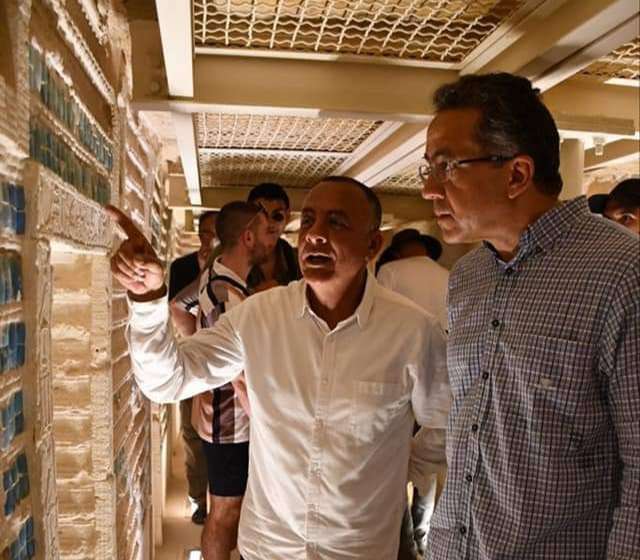On Monday, Khaled Al-Anani, Minister of Tourism & Antiquities, inaugurated the project of restoring the southern tomb of King Djoser in Saqqara, Giza Governorate, after completing operations there, which began in 2006.
The Minister was accompanied by Dr. Mostafa Waziri, Secretary-General of the Supreme Council of Antiquities, Brigadier Engineer Hisham Samir, Assistant Minister for Engineering Affairs, Eng. Waad Allah Abul-Ela, the engineering consultant for the projects sector, Sabri Farag, Director General of Saqqara Antiquities District, and Dr. Ashraf Owais, Director of the Saqqara Antiquities Restoration Department.
Upon the minister's arrival at Saqqara archaeological site, Al-Anani met with a number of tourists from Germany, Brazil, Russia, America, Spain, the Caribbean Islands, Poland and Portugal, who were keen to talk to him. They expressed their love for Egypt and its tourist destinations and what they saw of the greatness and nobility of the Egyptian civilization.

For his part, the Minister of Tourism & Antiquities invited tourists to accompany him to the opening of cemetery. The tourists expressed their happiness with this invitation, as they will be the first visitors to the cemetery in more than 15 years.
Waziri explained that the southern tomb of King Djoser is located in the southern corner of his funerary complex in the Saqqara antiquities area.
The southern tomb can be accessed by a stone staircase that leads to a door carved in the rock as well, then the entrance corridor with a stone staircase that leads in turn to the cemetery door, which leads to the interior corridors leading to the level of the cemetery spaces and the container for murals decorated with blue faience.
In the tomb, there is a well at the end of a burial chamber with a huge pink granite sarcophagus similar to the burial chamber in the Step Pyramid.
There are also many long corridors whose walls are decorated with fake doors bearing the image of the king and his titles, and the walls are decorated with pieces of blue faience.
Brigadier Engineer Hisham Samir indicated that the cemetery restoration project began in 2006, and included engineering, geotechnical, geo-environmental and archaeological studies of the cemetery.
He added that restoration of the lower corridors, strengthening the walls and ceilings, treating cracks and installing faience tiles to complete the interior elements of the cemetery.
The granite sarcophagus at the bottom of the burial well was reassembled and restored, in addition to rehabilitating the cemetery for visits by paving the floors, installing a ladder leading to the well and the cemetery, and fully lighting it.
The cemetery will be opened for visits as of tomorrow, Tuesday, September 14. The prices of visit tickets for Egyptians being 40 pounds, Egyptian students 20 pounds, foreigners 100 pounds, and foreign students 50 pounds.
The visit includes the entrance to the southern cemetery, the well to its end, and the sarcophagus.
On the occasion of the completion of the cemetery restoration project, journalists and media professionals will be allowed to visit and photograph the entire cemetery (including the corridors and corridors closed to visitors) free of charge, on an exceptional basis.
Translated by Ahmed Moamar





























